Straddling the Equator, 600 miles west of the (aptly named) port city of Manta on mainland Ecuador, the Galapagos Islands need little introduction. Since their accidental discovery by Bishop Tomas de Berlanga in 1535, followed by the famed visit of Charles Darwin 300 years later, the archipelago has captured the minds of biologists, naturalists and divers the world over. Ask any diver to choose their dream dive destination, and the 'natural selection' (pun intended) for many would be the Galapagos Islands. Facts abound regarding this special archipelago, whose geology is almost as fascinating as its flora and fauna. As well as inspiring Darwin's thoughts on evolution and natural selection, this small area in the eastern Pacific Ocean has been a birthplace of volcanoes for at least 20 million years. So, let's take a closer look at some fun Galapagos Islands facts and discover why these enchanted islands are such a big draw for divers.
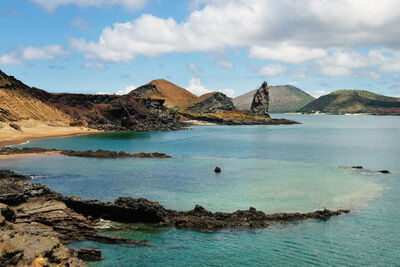
The island group is known by several names
The Galapagos Islands' official name isn't so appealing to English speakers; Archipielago de Colon doesn't conjure particularly pleasant images. But this name, derived from the Spanish for Columbus, is hardly used. The Galapagos Islands (Islas Galapagos) is by far the most common name used, with the moniker derived from the Spanish term for the islands' most famous residents - giant tortoises.
The group also has a few nicknames: Islands of the Tortoises, the Enchanted Islands (Islas Encantadas), the Ecuador Archipelago (Archipielago de Ecuador), and the Archipelago of the Equator (Archipielago del Ecuador). Why not choose your favourite?
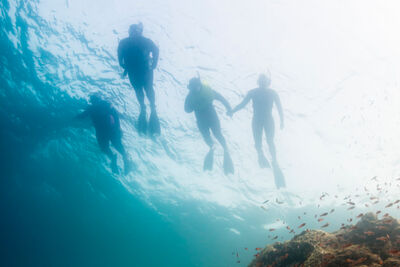
The first resident of the Galapagos Islands was Irish
The Irishman Patrick Watkins is believed to be the archipelago's first permanent resident. Little is known about this 19th-century sailor who became marooned on Floreana Island, to the south of the island group, in 1807. He's believed to have sustained himself by growing vegetables in a small patch of land.
The few reports available suggest he spent much of his time on the islands in a state of inebriation after trading his vegetables for rum with passing ships. One report included the following description: 'the appearance of this man, from the accounts I have received of him, was the most dreadful that can be imagined: ragged clothes, scarce sufficient to cover his nakedness, and covered with vermin; his red hair and beard matted, his skin much burnt from constant exposure to the sun; and so wild and savage in his manner and appearance that he struck everyone with horror.' Sounds charming.
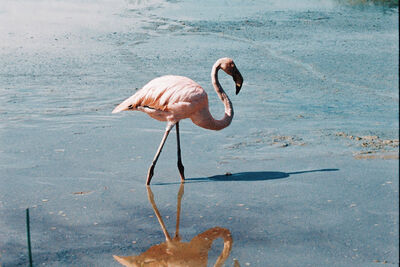
The islands are a hotspot for boobies and other birdlife
While you're free to spend your surface intervals any way you choose, make sure to enjoy some birdwatching - the islands' birdlife is almost as impressive as their marine life (yes, really). Three species of boobies call the Galapagos Islands home: red-footed boobies, blue-footed boobies and Nazca boobies. The distinct diets of the three species account for their different funky foot colourings, and you can find them on rocky shores and cliffs across the islands.
Darwin also famously did some birdwatching during the second voyage of HMS Beagle, which took him to the Galapagos Islands in 1835. In particular, the Galapagos finches caught his attention; Darwin noted that finches on different islands had uniquely shaped beaks, each adapted to their different food sources. This observation was key to forming his revolutionary yet, at the time, controversial theories about evolution and natural selection.
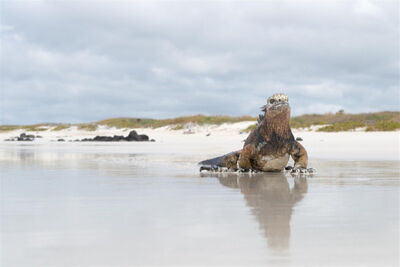
The Galapagos Islands are home to tropical penguins and freediving lizards
The Galapagos penguin (Spheniscus mendiculus) is the only species of penguin to stray north of the Equator. Endemic to the Galapagos Islands, they're mainly found on Fernandina Island and the west coast of Isabela Island. While penguins generally prefer cool conditions, luckily, the Humboldt and Cromwell currents bring colder water up from the southern seas. When diving, this means you'll need a thick-ish wetsuit, but the chance to dive with cute penguins far outweighs this minor inconvenience.
Described as 'hideous-looking' by Darwin, the Galapagos' marine iguanas also offer a distinct diving experience. They're the only species of lizard in the world known to spend time in the sea, and are also endemic to the Galapagos group. You may spot them in the shallows when doing your safety stops, as they like to cling to the rocks and feast on algae.
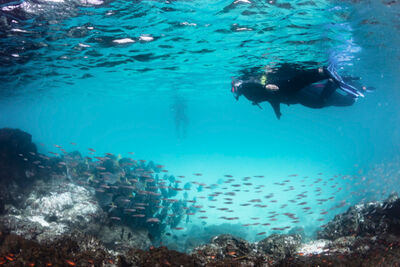
You can send postcards home for free
Historically, Floreana Island was a favourite stopover point for passing ships thanks to its reliable fresh water sources and relatively flat surface. Formed by a volcanic eruption, the island - once known as Charles Island - is home to Cerro Pajas, an inactive volcano and Floreana's highest peak.
The island is also home to the not-so-exotically-named Post Office Bay. During the 19th century, whalers placed a wooden barrel in the bay so that mail could be picked up and delivered to their destination by ships en route to Europe or the United States. This tradition is still alive today: simply pop your postcards and letters in the barrel without postage, and fellow visitors will sift through the mail to check if any are addressed to people near their hometowns. If so, they can then help them on their way. Galapagos Islands facts don't get wackier than this one…
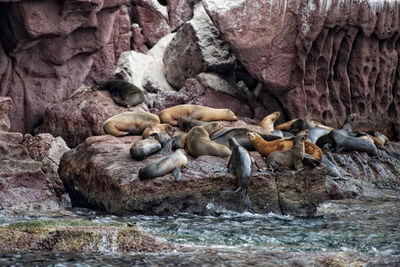
The Galapagos are a mecca for marine megafauna
Fancy a wetter version of an African game safari? The Galapagos Islands are the perfect choice. The waters surrounding the islands are home to 34 different species of shark alone. From the eponymous Galapagos sharks to sleek silky sharks, tremble-inducing tiger sharks and all three species of thresher sharks, the Galapagos is a shark lover's heaven. And that's without mentioning the whopping whale sharks and schooling scalloped hammerheads that frequent the waters around Wolf and Darwin Islands.
On top of all the sharks, you can also spot Galapagos penguins, sea lions, marine iguanas, manta rays, turtles, dolphins, duck-diving cormorants, tuna, devil rays, and even, on occasion, passing orcas. In addition to the plethora of pleasing underwater sights, the archipelago's remote location and strict governance ensure that the dive conditions remain pretty much pristine. Why not make it the natural selection when choosing your next luxury dive odyssey?
















